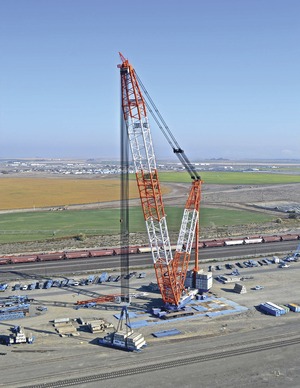
Heavy-lift specialist Lampson International LLC has finished load-testing its largest crane, the Transi-Lift LTL-3000, which can lift loads weighing 3,000 tonnes and is said to cost more than $25 million.
Standing today in Lampson's Kennewick, Wash., facility, the unit was sold in 2010 to Hitachi Transport Ltd. to build a now-delayed Higashidori nuclear powerplant for Tokyo Electric Power Co.
The LTL-3000 sports updated technology. "It's a departure from the previous Transi-Lifts in that the hoist system is entirely hydraulic," says Bryan Pepin-Donat, Lampson's director of contracts and international business. Previous models used friction drives, he explains.
As more projects are built in modules, larger cranes are needed to pick up and maneuver loads. Like other Transi-Lifts, this one has a fully pinned boom for ease of shipping, setup and dismantling.
The monster machine is rigged with 2-in.-dia wire rope, with up to 64 parts of line. Two 755-horsepower Cummins diesel engines power the drums, while four 335-hp diesels power each of the front and rear crawlers—a total of eight engines for movement.
"When you are counter-rotating, you need considerable torque," explains Pepin-Donat. "Each crawler can counter-rotate 360° given that you are sitting on a reasonable pad."
A variety of configurations complement the crane's hefty load curve. With a 104-meter main boom, it can lift 3,000 tonnes at a 32-m radius. At 60 m, it can pick more than 1,500 tonnes. The main boom and jib can be built up to 160 m and 100 m long, respectively.
Lampson's next-largest model, the LTL-2600, ranked in 2012 as one of the world's largest mobile cranes, ENR reported. Like that machine, the LTL-3000 can pick and carry.
Lampson's newest conventional cranes, called the Millennium Series, are old-but-sturdy Manitowoc 4100 friction crawlers, updated with modern hydraulic drums, clean-diesel engines and joystick controls.
"We're getting a very big response to them," says Pepin-Donat.








Post a comment to this article
Report Abusive Comment